知母 对照药材
| 储存条件 | RT,避光 |
| 规格 | 1g |

知母 对照药材
| 储存条件 | RT,避光 |
| 规格 | 1g |
知母皂苷BII 标准品
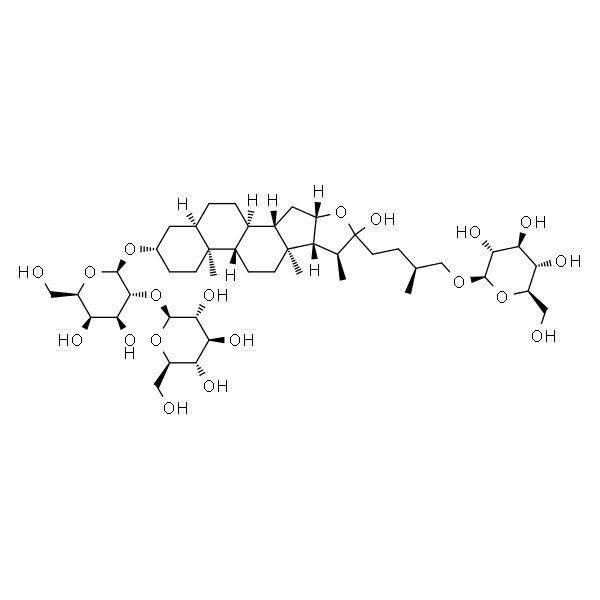
| 英文名称 | Timosaponin BII |
| CAS | 136656-07-0 |
| 分子式 | C45H76O19 |
| 分子量 | 921.084 |
| 储存条件 | 2-8℃ |
| 规格 | 20mg |
熔点:>243
Timosaponin BII 知母皂苷BII 标准品
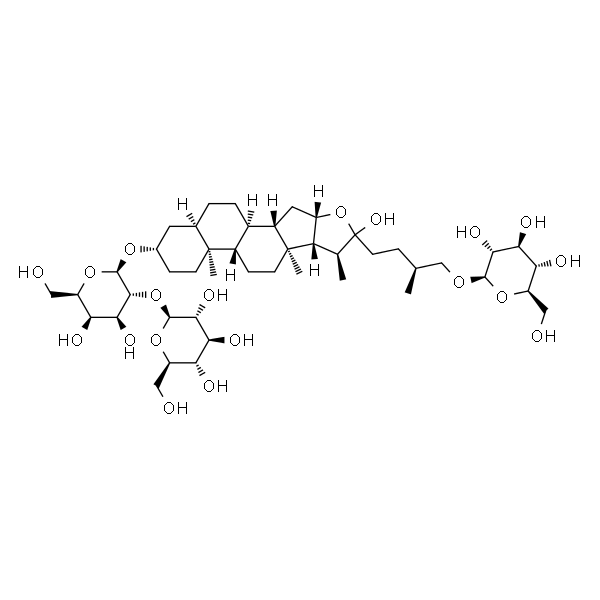
| MDL | MFCD30179489 |
| 别名 | 知母皂苷B2; |
| 英文名称 | Timosaponin BII |
| CAS | 136656-07-0 |
| 分子式 | C45H76O19 |
| 分子量 | 921.08 |
| 储存条件 | 2-8℃ |
| 纯度 | HPLC≥98% |
| 外观(性状) | Yellow Powder |
| 单位 | 瓶 |
| SMILES | C[C@@]1([C@]([C@@H]2C)([H])[C@](O[C@]2(O)CC[C@H](C)CO[C@@H]([C@@H]([C@@H](O)[C@@H]3O)O)O[C@@H]3CO)([H])C4)[C@]4([H])[C@@](CC[C@@]5([H])[C@@]6(CC[C@H](O[C@@](O[C@H](CO)[C@H](O)[C@@H]7O)([H])[C@@H]7O[C@]([C@@H]([C@@H](O)[C@@H]8O)O)([H])O[C@@H]8CO)C5)C)([H])[C@]6([H])CC1 |
| 规格 | 20mg |
Timosaponin BⅡ;知母皂苷BⅡ



| MDL | MFCD30179489 |
| 别名 | 知母皂苷B2 |
| 英文名称 | Timosaponin BⅡ |
| CAS | 136656-07-0 |
| 分子式 | C45H76O19 |
| 分子量 | 921.07 |
| 纯度 | HPLC≥98% |
| 单位 | 瓶 |
| 生物活性 | Timosaponin BII 是一种抗氧化剂和抗炎化合物。[1-2] |
| In Vitro | Timosaponin BII是一种从Zhi Mu中分离出的甾体糖苷,被发现具有抑制HL-60(白血病),Hela(子宫颈),HepG2和Bel-7402(肝脏),HT-29(结肠)增殖的抑制活性,和MDA-MB-468(乳腺)人癌细胞系在HL-60细胞中的IC50值为15.5μg/ mL [1]。 |
| In Vivo | 模型组和载体对照组中的大鼠视网膜表现出BACE1表达的明显上调。同时,丙二醛(MDA),Aβ1-40和β-CTF的水平增加。然而,当与媒介物对照组相比时,Timosaponin-BII处理组中的视网膜显示出显著更少的BACE1并且累积更少的Aβ1-40或β-CTF。它还显示MDA水平显著降低和部分凝血活酶时间延长[2]。 |
| SMILES | C[C@@]1([C@]([C@@H]2C)([H])[C@](O[C@]2(O)CC[C@H](C)CO[C@@H]([C@@H]([C@@H](O)[C@@H]3O)O)O[C@@H]3CO)([H])C4)[C@]4([H])[C@@](CC[C@@]5([H])[C@@]6(CC[C@H](O[C@@](O[C@H](CO)[C@H](O)[C@@H]7O)([H])[C@@H]7O[C@]([C@@H]([C@@H](O)[C@@H]8O)O)([H])O[C@@H]8CO)C5)C)([H])[C@]6([H])CC1 |
| 靶点 | Others |
| 数据来源文献 | [1]. Guo J, et al. Cytotoxic activities of chemical constituents from rhizomes of Anemarrhena asphodeloides and their analogues. Arch Pharm Res. 2015;38(5):598-603. [2]. Huang JF, et al. Timosaponin-BII inhibits the up-regulation of BACE1 induced by ferric chloride in rat retina. BMC Complement Altern Med. 2012 Oct 22;12:189. |
| 规格 | 5mg 10mg 20mg |
Timosaponin BII 是一种抗氧化剂和抗炎化合物。
使用本产品的应用案例(仅供参考)
In Vitro
In Vitro Incubation of Timosaponin BII with Gut Microbiota
After 7 SD rats were sacrificed, the colon contents were collected and added to the sterilized anaerobic medium (Jinpan Life Sciences Co., Ltd., Beijing, China) at a ratio of 1.0 g:20 mL, and stirred gently. After filtering, the culture medium containing gut microbiota (mixed medium) was placed in a N2 atmosphere, and pre-incubated at 37 ◦C for 60 min before use. Accurately weigh 1.0 mg of timosaponin BII and dissolve with methanol to obtain a solution of 1 mg/mL. The incubation system consists of 10 µL of timosaponin BII in methanol (1 mg/mL), and 990 µL of mixed medium. The incubation was conducted in a 37 ◦C, 200 rpm shaking incubator. The incubation system must be maintained completed in an anaerobic environment during the experiment. In the first incubation experiment, the timosaponin BII and mixed medium were incubated for 0, 1, 2, 6, 12, and 24 h, respectively. In the second incubation experiment, the drugs and mixed medium were incubated for 0, 0.25, 0.5, 1, 1.5, and 2 h, respectively. In addition, the negative control group was introduced consisting of twice boiled mixed medium incubated with the same amount of timosaponin BII. The termination reaction was carried out by adding 3-fold volume of 100 ng/mL glipizide methanol solution (IS), shaking it evenly and then precipitating the protein. After each sample was centrifuged at 13,400× g rpm in a 4 ◦C refrigerated centrifuge for 10 min, 10 µL of supernatant was injected for LC-MS/MS analysis, and 7 µL of supernatant was injected for LC/MS-Q-TOF analysis.
In Vitro Incubation of Timosaponin BII with Liver Microsomes and Liver Homogenate
The liver microsome incubation system was consisted of the following: 5 µL SD rat liver microsomes (20 mg/mL), 2 µL timosaponin BII (1 mM), 20 µL of NADPH, and 0.05 mM Tris/HCl (pH = 7.4), with a total volume of 200 µL. The incubation was conducted in a shaking incubator at 37 ◦C and 800 rpm with supply of oxygen. After the incubation, 3-fold volume of glipizide methanol solution (IS, 100 ng/mL) was added to the incubation system and mixed to stop the reaction at 0, 0.25, 0.5, 1, 1, 5, and 2 h. After centrifugation at 13,400× g rpm in a refrigerated centrifuge at 4 ◦C for 10 min, 10 µL of the supernatant was injected for LC-MS/MS analysis.
Liver homogenate was prepared by homogenizing freshly collected SD rat livers and adding ice-cold normal saline with weight/volume = 1:3. The liver homogenate incubation system was consisted as follows: 2 µL timosaponin BII (1 mM), 198 µL of freshly prepared liver homogenate, with a total volume of 200 µL.
Incubation was conducted in a shaking incubator at 37 ◦C and 800 rpm with supply of oxygen. After the incubation, 3-fold volume of glipizide methanol solution (IS, 100 ng/mL) was added to the incubation system and mixed to stop the reaction at 0, 0.25, 0.5, 1, 1, 5, and 2 h. After centrifugation at 13,400× g rpm in a refrigerated centrifuge at 4 ◦C for 10 min, 10 µL of the supernatant was injected for LC-MS/MS analysis.
来源文献:Dong GM, Yu H, Pan LB, Ma SR, Xu H, Zhang ZW, Han P, Fu J, Yang XY, Keranmu A, Niu HT, Jiang JD, Wang Y. Biotransformation of Timosaponin BII into Seven Characteristic Metabolites by the Gut Microbiota. Molecules. 2021 Jun 24;26(13):3861. doi: 10.3390/molecules26133861. PMID: 34202717; PMCID: PMC8270264.
Timosaponin A3 知母皂苷A3 标准品
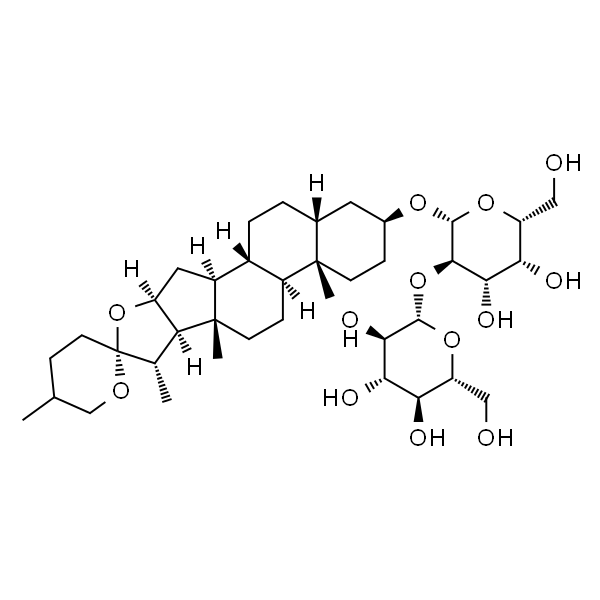
| MDL | MFCD01631164 |
| 别名 | 知母皂苷A-III; |
| 英文名称 | Timosaponin A3 |
| CAS | 41059-79-4 |
| 分子式 | C39H64O13 |
| 分子量 | 740.93 |
| 储存条件 | 2-8℃ |
| 纯度 | HPLC≥98% |
| 外观(性状) | Off-white Powder |
| 单位 | 瓶 |
| SMILES | C[C@@]12[C@]([C@@H]3C)([H])[C@](O[C@]34CC[C@H](C)CO4)([H])C[C@@]1([H])[C@@](CC[C@@]5([H])[C@@]6(CC[C@H](O[C@@](O[C@H](CO)[C@H](O)[C@@H]7O)([H])[C@@H]7O[C@]([C@@H]([C@@H](O)[C@@H]8O)O)([H])O[C@@H]8CO)C5)C)([H])[C@]6([H])CC2 |
| 规格 | 20mg |
知母皂苷E 标准品
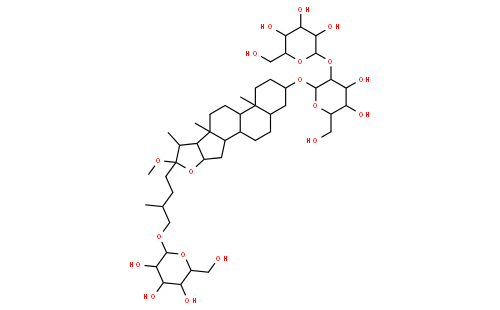
| CAS | 136565-73-6 |
| 分子式 | C46H78O19 |
| 分子量 | 935.1 |
| 单位 | 瓶 |
| 规格 | 10mg |
生化实验用标准品
Timosaponin A3;知母皂苷A3
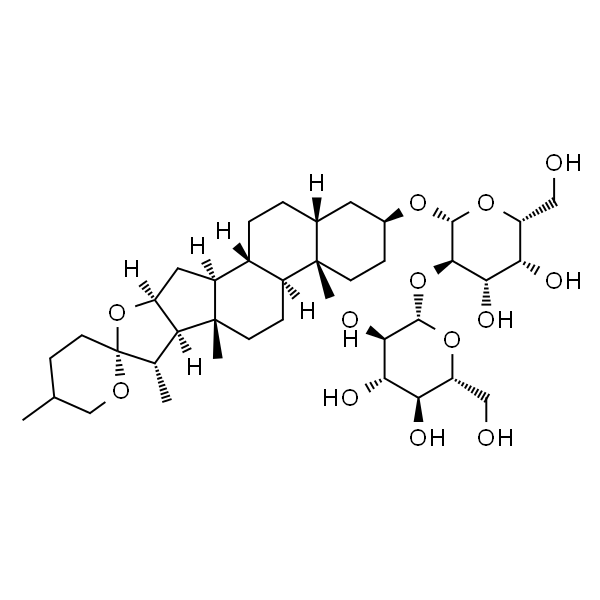
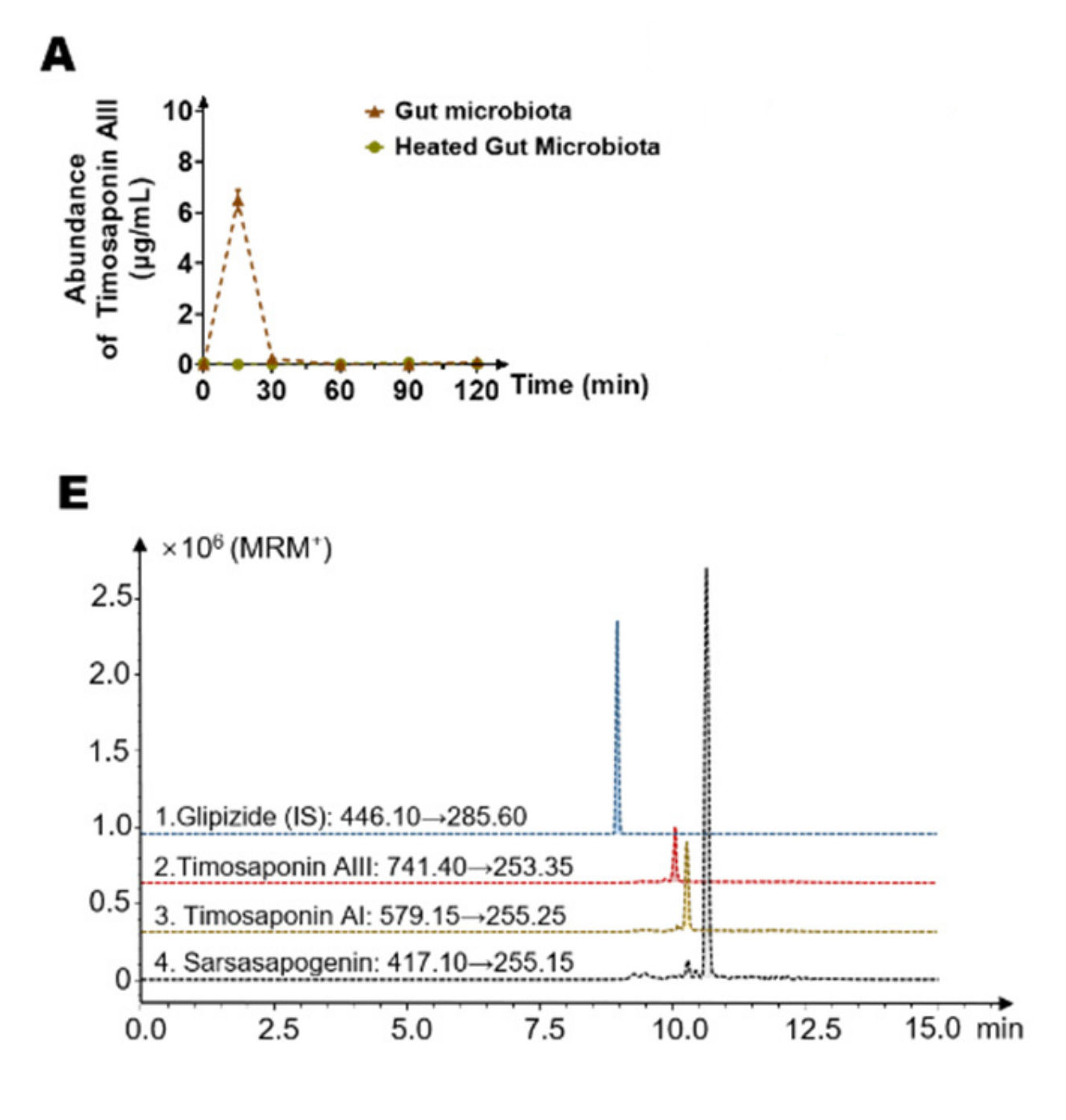
| MDL | MFCD01631164 |
| 别名 | 知母皂苷A-III |
| 英文名称 | Timosaponin A3 |
| CAS | 41059-79-4 |
| 分子式 | C39H64O13 |
| 分子量 | 740.92 |
| 纯度 | HPLC≥98% |
| 单位 | 瓶 |
| 生物活性 | Timosaponin AIII 能够抑制 乙酰胆碱酯酶 (AChE) 的活性,其 IC50 值为 35.4 μM。[1] |
| IC50 | 35.4 μM (AChE)[1]. |
| In Vitro | Timosaponin AIII被鉴定为BN108中的主要选择性细胞毒活性,其选择性细胞毒活性涉及mTOR的抑制,ER应激的诱导和保护性自噬[2]。 |
| In Vivo | 在测试的甾体皂苷中,Timosaponin AIII(TA3)最有效地改善记忆缺陷。 Timosaponin AIII使东莨菪碱诱导的逐步潜伏期减少17%(10 mg/kg),28%(20 mg/kg)和43%(40 mg/kg)。在采集试验期间,没有观察到潜伏时间的差异。 Timosaponin AIII(20,40 mg/kg,po)有效抑制东莨菪碱处理的小鼠脑中乙酰胆碱的这种减少。 Timosaponin AIII的抑制作用与他克林的抑制作用相当,后者可用作阳性对照[1]。 |
| SMILES | C[C@@]12[C@]([C@@H]3C)([H])[C@](O[C@]34CC[C@H](C)CO4)([H])C[C@@]1([H])[C@@](CC[C@@]5([H])[C@@]6(CC[C@H](O[C@@](O[C@H](CO)[C@H](O)[C@@H]7O)([H])[C@@H]7O[C@]([C@@H]([C@@H](O)[C@@H]8O)O)([H])O[C@@H]8CO)C5)C)([H])[C@]6([H])CC2 |
| 靶点 | AChE |
| 动物实验 | 小鼠[1]使用体重28-30g的雄性ICR小鼠。对于采集试验,最初将小鼠放置在照明隔室中,并且在两个隔室之间的门在10秒后打开。每组包含10只小鼠。在采集试验前1小时或5小时,小鼠接受每种测试剂(例如,Timosaponin AIII 10,20或40mg/kg,po)。在采集试验前一小时,小鼠接受他克林(10mg/kg,口服)作为阳性对照。在给予测试剂,他克林或10%吐温80溶液后0.5小时或4.5小时,东莨菪碱处理(1mg/kg,ip)诱导记忆障碍。对照动物单独施用10%吐温80溶液。在采集试验后二十四小时,将小鼠再次置于照明隔室中用于保留试验。在门打开后鼠标进入暗室的时间被测量为采集和保留试验中的潜伏时间,最大值为300秒[1]。 |
| 数据来源文献 | [1]. Lee B, et al. Timosaponin AIII, a saponin isolated from Anemarrhena asphodeloides, ameliorates learning and memory deficits in mice. Pharmacol Biochem Behav. 2009 Aug;93(2):121-7. [2]. King FW, et al. Timosaponin AIII is preferentially cytotoxic to tumor cells through inhibition of mTOR and induction of ER stress. PLoS One. 2009 Sep 30;4(9):e7283. |
| 规格 | 5mg 10mg 20mg |
Timosaponin AIII 能够抑制 乙酰胆碱酯酶 (AChE) 的活性。